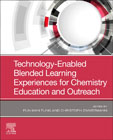
Technology-Enabled Blended Learning Experiences for Chemistry Education and Outreach
Fung, Fun Man
Zimmermann, Christoph
The introduction of new technology offers huge potential for the enhancement of chemistry education, particularly for topics which can be difficult to show in traditional 2d media. However, whilst the introduction of such technologies can inspire great optimism, their tangible effects and real-world applicability are not always clearly defined. This results in a dilemma for educators, who are often excited by the idea of such novel technologies but unaware of the most effective ways to implement them in their curriculum. Technology-enabled blended learning experiences for chemistry education and outreach provides a comprehensive overview of both theory and practical implementation suggestions, equipping educators with the knowledge they need to implement technology effectively and creatively in their chemistry teaching. Beginning with a guide to the theoretical background of technologies currently in use, part 1 introduces readers to the current landscape and provides a solid foundation to understanding how technology can be usefully integrated in learning and teaching chemistry content. Part 2 then delves into the specifics of implementing technology, how to design the curriculum with tech in mind, and how it can be applied to both outreach & evaluation efforts. Finally, part 3 presents case studies of technology already being implemented. This provides the reader with some practicable examples describing applications of the theories & technologies they have just learned about Drawing on the broad experiences and unique insights of a global team of authors from a whole host of different backgrounds, technology-enabled blended learning experiences for chemistry education and outreach aims to stimulate readers' creativity and inspire them to find their own novel applications of the techniques highlighted in this volume. Provides detailed information on the theoretical background of technology usage in chemistry educationHelps readers understand available options and make informed decisions on how to best utilize technology to enhance their chemistry teachingPresents examples of theory in practice through case studies detailing completed implementations from around the world INDICE: Part 1: Foundations in technology-enabled blended learning experiences 1. Creative innovative, immersive learning experiences using virtual reality 2. Theoretical background on technology-enabled learning from an instructional designer's point of view 3. Reverse-engineering learning apps - DuoLingo, Chinese Skills and Elevate Part 2: Curriculum design, implementation, and evaluation, outreach 4. Mobile phone apps for organic chemistry 5. Interactive and innovative practices to stimulate learning processes in biochemistry 6. The importance of designing blended learning experiences in a way which produces clean data to allow proper observation of student participation 7. Adopting a Flipped Classroom to teach and learn SciFinder in an Undergraduate Chemistry Laboratory Course 8. Using an NMR Software as an Instructional Tool in Elucidating Organic Structures Part 3: Case Studies 9. Six Years of Flipping University Chemistry in Multi-Site, Synchronously Delivered, Geographically Dispersed Chemistry Courses 10. A method of delivering timely personalised feedback to large student cohorts which requires almost no additional resources 11. Created a system of tracked and directed engagement with resources such as videos for each student and quiz questions which mark students own results and use varying different grading strategies 12. Applying a Nucleophile's Point of View? (NuPOV) Mobile App to Support Students' 3-Dimensional Visualization Skills
- ISBN: 978-0-12-822879-1
- Editorial: Elsevier
- Encuadernacion: Rústica
- Páginas: 150
- Fecha Publicación: 01/02/2021
- Nº Volúmenes: 1
- Idioma: Inglés
